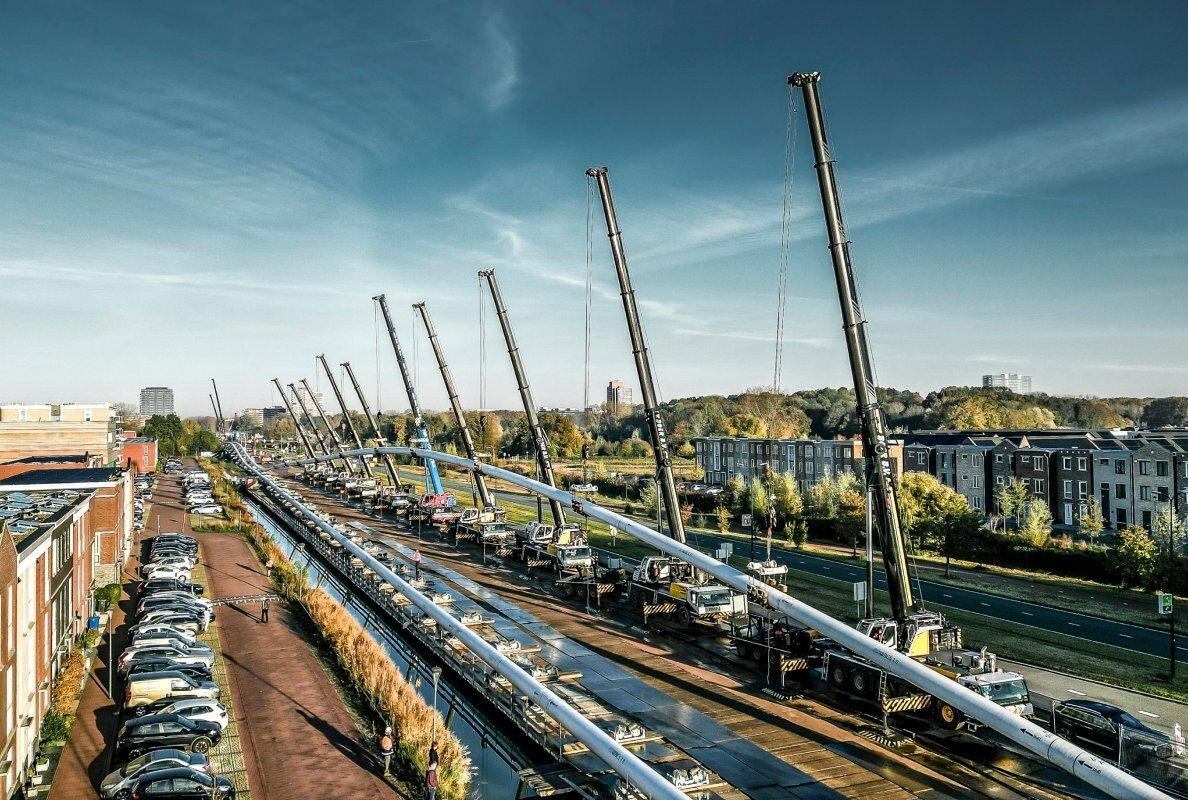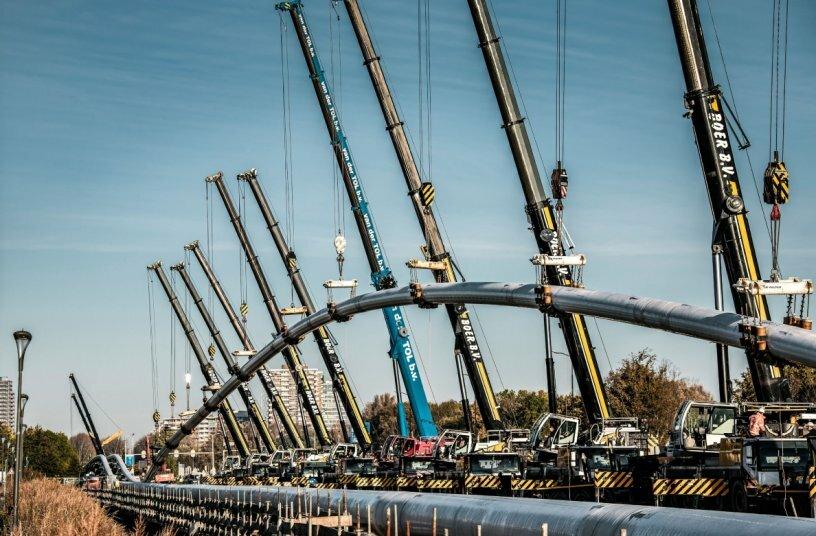LIEBHERR-Twelve mobile cranes in operation during the construction of a pipeline in Delft
 11/03/24-FR-English-NL-footer
11/03/24-FR-English-NL-footer
LIEBHERR-Douze grues mobiles en opération lors de la construction d'un pipeline à Delft

 A dozen cranes in a row: the Boer B.V. cranes were used in tandem on a pipeline construction project for the district heating network in the Netherlands. IMAGE SOURCE: Liebherr-Werk Ehingen GmbH
A dozen cranes in a row: the Boer B.V. cranes were used in tandem on a pipeline construction project for the district heating network in the Netherlands. IMAGE SOURCE: Liebherr-Werk Ehingen GmbH
Une douzaine de grues mobiles de Boer B.V. ont posé une canalisation d'un kilomètre de long avec une courbure prédéfinie
Le pipeline a été creusé dans le sol pour le réseau de chauffage urbain
Une douzaine pour la transition énergétique : douze grues mobiles d'une capacité de levage allant de 90 à 400 tonnes ont été utilisées pour construire un pipeline à Delft aux Pays-Bas. Les grues mobiles ont soulevé un pipeline d'une longueur totale d'un kilomètre afin de l'amener dans la bonne position pour son insertion dans le sol. Le gazoduc fait partie du réseau de chauffage urbain, qui est actuellement en cours d'extension afin de convertir les systèmes de chauffage en sources d'énergie durables.
Richard Rijbroek est responsable environnemental chez Denys et a supervisé la construction du pipeline à Delft. Le client est Nederlandse Gasunie NV. Rijbroek explique : « Les préparatifs du projet « WarmtelinQ » sont en cours depuis trois ans. Nous utiliserons la chaleur résiduelle de l’industrie du port de Rotterdam et des usines d’incinération des déchets pour chauffer des habitations et des entreprises en Hollande méridionale. » Le pipeline relie le port de Rotterdam à La Haye via Vlaardingen.
Une tête de forage a été installée d'un côté de la canalisation de chauffage urbain de 1 000 mètres de long, comme l'explique Harm van Dijk, chef de projet du grutier néerlandais Boer B.V. : « Nous forons ici un forage pour le réseau de chauffage. Le pipeline est creusé dans le sol. Pour ce faire, le pipeline doit être soulevé et placé dans une certaine courbe afin qu'il soit percé dans le sol selon un angle défini.
Selon van Dijk, la longueur de l'arc rétractable est de 275 mètres : « Pour obtenir la courbure exacte, nous formons l'arc avec dix grues. Chacune de ces grues soulève 18 tonnes. C'est pour cette raison que nous avons besoin ici de machines d'une capacité de 90 à 140 tonnes. De l’autre côté de l’autoroute, nous avons utilisé une grue de 300 tonnes et une de 400 tonnes en raison du grand porte-à-faux. Le pipeline d'un kilomètre de long ne peut pas être entièrement préassemblé sur le terrain, car une autoroute et un pont traversent le tracé. Il était donc stocké sur des conteneurs à une hauteur suffisante selon les besoins.
NJC.© Info LIEBHERR
------------------------------------------------------------------------------------------------------------------
 11/03/24-English
11/03/24-English
LIEBHERR-Twelve mobile cranes in operation during the construction of a pipeline in Delft

 A dozen cranes in a row: the Boer B.V. cranes were used in tandem on a pipeline construction project for the district heating network in the Netherlands. IMAGE SOURCE: Liebherr-Werk Ehingen GmbH
A dozen cranes in a row: the Boer B.V. cranes were used in tandem on a pipeline construction project for the district heating network in the Netherlands. IMAGE SOURCE: Liebherr-Werk Ehingen GmbH
A dozen mobile cranes from Boer B.V. laid a one-kilometre-long pipeline with a predefined curvature
The pipeline was drilled into the ground for the district heating network
A dozen strong for the energy transition: twelve mobile cranes with lifting capacities ranging from 90 to 400 tonnes were used to build a pipeline in Delft in the Netherlands. The mobile cranes lifted a pipeline with a total length of one kilometre in order to bring it into the correct position for insertion into the ground. The pipeline is part of the district heating network, which is currently being expanded in order to convert heating systems to sustainable energy sources.
Richard Rijbroek is an environmental manager at Denys and supervised the construction of the pipeline in Delft. The client is Nederlandse Gasunie NV. Rijbroek explains: “Preparations for the “WarmtelinQ” project have been underway for three years. We will use the residual heat from industry in the port of Rotterdam and from waste incineration plants to heat homes and businesses in South Holland.” The pipeline runs from the port of Rotterdam to The Hague via Vlaardingen.
A drill head was installed on one side of the 1,000 metre long district heating pipeline, as Harm van Dijk, project manager of the Dutch crane operator Boer B.V., explains: “We are drilling a bore here for the heating network. The pipeline is drilled into the ground.” To do this, the pipeline has to be lifted up and placed in a certain curve so that it is drilled into the ground at a defined angle.
According to van Dijk, the length of the retractable arch is 275 metres: “To get the exact curvature, we form the arch with ten cranes. Each of these cranes lifts 18 tonnes. For this reason we need machines with a capacity of 90 – 140 tonnes here. On the other side of the motorway, we used a 300-tonne and a 400-tonne crane because of the large overhang.” The kilometre-long pipeline cannot be completely preassembled on the ground, as a motorway and a bridge cross the route. It was therefore stored on containers at a sufficient height as required.
NJC.© Info LIEBHERR
------------------------------------------------------------------------------------------------------------------
 11/03/24-NL
11/03/24-NL
LIEBHERR-Twaalf mobiele kranen in bedrijf tijdens de aanleg van een pijpleiding in Delft

 A dozen cranes in a row: the Boer B.V. cranes were used in tandem on a pipeline construction project for the district heating network in the Netherlands. IMAGE SOURCE: Liebherr-Werk Ehingen GmbH
A dozen cranes in a row: the Boer B.V. cranes were used in tandem on a pipeline construction project for the district heating network in the Netherlands. IMAGE SOURCE: Liebherr-Werk Ehingen GmbH
Een tiental mobiele kranen van Boer B.V. legden een één kilometer lange leiding aan met een vooraf gedefinieerde kromming
Voor het stadsverwarmingsnet werd de leiding de grond in geboord
Een tiental sterk voor de energietransitie: twaalf mobiele kranen met een hijsvermogen van 90 tot 400 ton werden ingezet voor de aanleg van een pijpleiding in Delft. De mobiele kranen hebben een pijpleiding met een totale lengte van één kilometer opgetild om deze op de juiste positie te brengen om in de grond te worden gestoken. De leiding maakt deel uit van het stadsverwarmingsnetwerk, dat momenteel wordt uitgebreid om verwarmingssystemen om te zetten naar duurzame energiebronnen.
Richard Rijbroek is omgevingsmanager bij Denys en begeleidde de aanleg van de pijpleiding in Delft. De opdrachtgever is de Nederlandse Gasunie NV. Rijbroek legt uit: “De voorbereidingen voor het project ‘WarmtelinQ’ zijn al drie jaar bezig. De restwarmte van de industrie in de Rotterdamse haven en van afvalverbrandingsinstallaties gaan we gebruiken om woningen en bedrijven in Zuid-Holland te verwarmen.” De pijpleiding loopt van de haven van Rotterdam via Vlaardingen naar Den Haag.
Aan één zijde van de 1.000 meter lange stadsverwarmingsleiding is een boorkop geplaatst, vertelt Harm van Dijk, projectmanager van het Nederlandse kraanmachinist Boer B.V.: “We boren hier een boring voor het warmtenet. De pijpleiding wordt de grond in geboord.” Hiervoor moet de pijpleiding omhoog worden getild en in een bepaalde bocht worden geplaatst, zodat deze onder een bepaalde hoek de grond in wordt geboord.
Volgens van Dijk is de lengte van de uitschuifbare boog 275 meter: “Om de exacte kromming te krijgen, vormen we de boog met tien kranen. Elk van deze kranen hijst 18 ton. Daarom hebben we hier machines nodig met een capaciteit van 90 – 140 ton. Aan de andere kant van de snelweg hebben we vanwege de grote overhang een 300 ton en een 400 ton kraan ingezet.” De kilometerslange pijpleiding kan niet volledig op de grond worden voorgemonteerd, omdat een snelweg en een brug het tracé kruisen. Daarom werd het naar behoefte op containers op voldoende hoogte opgeslagen.
NJC.© Info LIEBHERR
--------------------------------------------------------------------------------------------------------------------
Date de dernière mise à jour : 08/03/2024
















